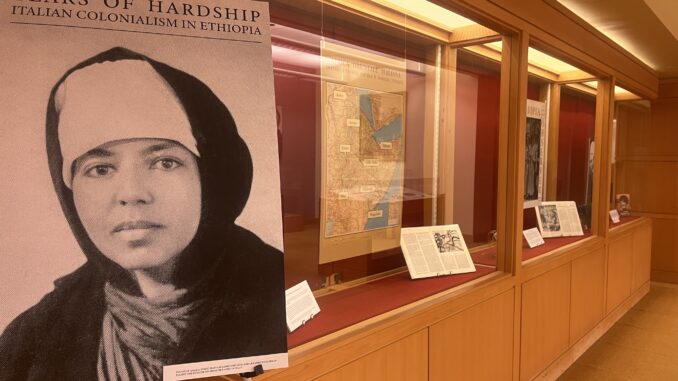
By Paulina Gajewski
The ethos of the mid-twentieth century was imbued with colonialism and struggle between foreign powers. At the zenith of colonial domination, over half of the world’s territories were partitioned between European empires, and in later years, anticolonial sentiments and movements grew stronger. Such movements took upon various forms, and in recent years society has aimed to depict the histories and unfortunate legacies of colonialism.
This month, the Brooklyn College Library unveiled a new exhibit titled “Years of Hardship: Colonialism in the Horn of Africa from 1935-1941.” Beneath the cases and across the walls were placed books, photographs, documents, and other mediums regarding Italian colonialism in Ethiopia.
Spearheaded by BC archivist Colleen Bradley-Sanders, the exhibit drew upon artifacts and items from the Robert L. Hess collections on Ethiopia and the Continent of Africa, the bulk of which had been donated by his wife. Hess, the sixth president of BC, was a noted scholar of Ethiopian History and devoted to the colonial period.
The exhibition was conceived by collaborative efforts. “The inspiration for the exhibit came from conversations with a colleague at John Jay College: Professor James DeLorenzi,” Bradley-Sanders told The Vanguard. “He’s very familiar with our Hess Collection on Ethiopia and the Horn of Africa, having both used it for his own research, as well as providing expert advice when I’m considering purchasing different archival collections.”
In 1935, dictator Benito Mussolini invaded Ethiopia, and the following year established a new colony. The former emperor, Haylä Sellasé, fled into exile with his administration and the subsequent takeover came to be known in Ethiopia as the “Years of Hardship.”
Conceptualizing and creating exhibitions is no small feat. “[Professor James DeLorenzio] came up with the theme, and we worked together to decide which books and images best represented the various elements of that theme, as well as which archival manuscript collections were relevant to the topics,” Bradley-Sanders said. In addition to the pieces already present within the collections, funding from the Hess endowment for the archives ensured Bradley-Sanders could purchase other supporting archival materials.
The effort to create settler colonies in Ethiopia was an imagined solution to the mass emigration of Italians to the Americas, as a way of keeping them within the Italian economy. Settler colonialism, based on the displacement and elimination of indigenous peoples, was supported by the Italian military occupations of Ethiopia, much of which played out under the Viceroy, or Governor General. Books on display presented the “leadership cults” that developed during the period.
The cases were dotted with photographs and images of the Viceroys. Paired with such images were documents from colonial official Tullio Antonelli that described his plans for training military troops and provided outlines for developing a counterinsurgency doctrine.
Within Ethiopia, anticolonial resistance movements arose. Men and women from all walks of life joined the anticolonial guerillas who spent five years ambushing Italian troops. Placed in the exhibit was an illustration depicting Abebe Aregai, a famous guerilla commander that the Italian troops were determined on capturing, to no avail.
Emperor Haylä Sellasé initially fled into exile, but became the national face for resistance, and placed within the case is his astonishing autobiography which details his actions during this period. His wife, Empress Menen Asfaw, was a defender of Ethiopian freedom and led the Ethiopian Red Cross war effort, contacting international feminist organizations to aid the cause.
Understanding colonial histories sheds light onto the social and political facets and foundations of today’s society, and such is the goal of these historical exhibitions.
“These events […] shaped the lives of millions of people,” as written in the exhibition’s description, “and they continue to reverberate in our contemporary world.”
“Years of Hardship” will be displayed in the “Archives and Special Exhibitions Area” in the BC Library until Sept. 2024.
